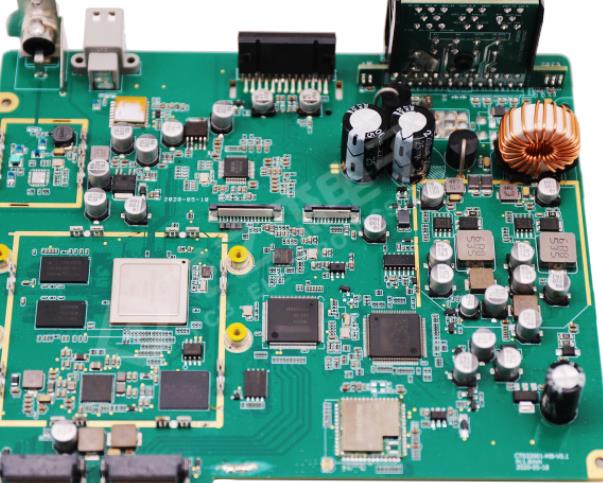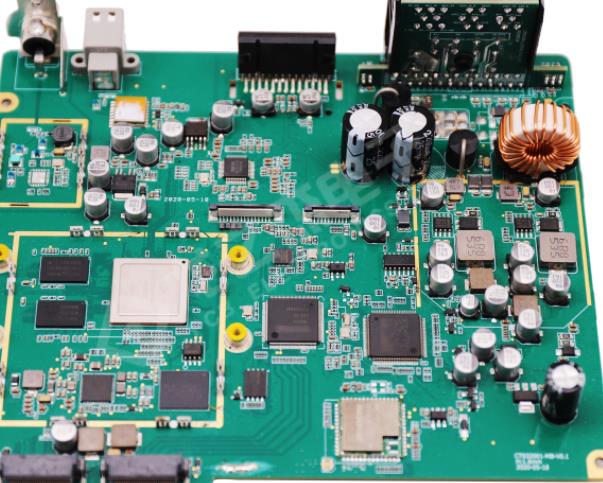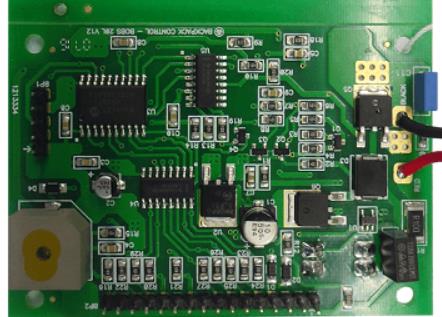Building 6, Zone 3, Yuekang Road,Bao'an District, Shenzhen, China
+86-13410863085Mon.-Sat.08:00-20:00

SMT reflow and SMT repair of wrong parts
Reflow soldering is the last process of SMT production Its defects combine the defects of printing and repair, including less tin, short circuit, side standing, offset, missing parts, multiple components, wrong parts, upside down, upside down, and vertical tablets, cracks, tin beads, gaps, gaps, luster, among which tombstones, cracks, tin beads, gaps, gaps, and luster are unique defects after welding
Tombstone: the phenomenon that one end of the part leaves the base plate and rises diagonally or vertically.
Solder connection or short circuit: solder joint connection occurs between two or more unconnected solder joints, or between solder joints and
The adjacent wires are poorly connected.
Displacement/offset: the component deviates from the predetermined position in the horizontal (level), vertical (vertical) or rotation direction of the liner.
Blank welding: assembly phenomenon where the weldable end of an assembly is not connected to a pad.
Reverse direction: wrong direction when installing polarization components.
Wrong part: the type and specification of the parts installed in the specified position do not meet the requirements.
Small pieces: no data need to be placed where there are components.
Copper exposure: the green oil PCBA surface on the surface peels off or is damaged, leading to the exposure of copper foil
Foaming: PCBs/PCBs surface is deformed due to regional expansion.
Tin hole: after the furnace, there are air holes and pinholes on the solder joints of the parts.
Tin crack: A crack on the surface of tin.
Warping feet: the feet of multi pin components are warped and deformed.
Side bracket: the side of the welding end of the directly welded component.
Weak welding/false welding: the parts are not firmly welded and have poor contact due to external or internal stress.
Reverse/reverse white: component list and silk screen are pasted on the other side of PCB, and the silk screen font of product name and specification cannot be recognized.
Cold welding/non molten tin: the surface of the solder joint is not shiny, and the crystal is not completely melted, so as to achieve reliable welding effect.
Reasons and judgments of displacement, reverse rotation, side standing, missing parts and wrong parts during SMT placement
All SMT work is related to welding. On the SMT process flow chart, after the SMT machine is welded, the SMT machine is not only the mechanical equipment with the highest SMT technology content, but also the final quality assurance before welding. In this regard, the quality of SMT plays a crucial role in the whole process of SMT.
Under the modern production and processing concept, product quality has become the lifeblood of the company. On the SMT assembly line, after passing the placement machine, PCB will face the heating of reflow soldering and welding molding, that is, the placement quality of components directly determines the quality of the entire product. This article will take the real object as a reference to enable relevant SMT practitioners to judge the quality of patches.
Poor, can correctly handle patch defects.
Defect type definition, formation cause judgment standard, judgment picture displacement, removal of component terminals or electrode pieces from copper foil, exceeding the judgment standard
1. The installation coordinates or angles are cheap, and the components are not installed in the middle of the copper foil.
2. Improper selection of camera recognition method leads to poor recognition and transmission effect.
3. The positioning of the base plate is unstable, the benchmark is set improperly, or the sleeve moves improperly.
4. The suction position moves, causing the suction nozzle to move when the part is not being sucked in.
5. The data parameters in the parts database are set incorrectly (for example, the suction nozzle is set incorrectly), resulting in placement and movement
1. The longitudinal or transverse deviation of the assembly is less than or equal to 1/4 of the width of the assembly pin, and there are contact pads at both ends of the transverse (longitudinal) direction.
2. There is contact solder paste at both ends of the element.
3. The polarity mark is vague but recognizable,
The direction is correct. The reason for displacement during SMT placement is contrary to the judgment standard. When placing a component, the polarity of the component does not match the polarity of the corresponding PCB mark.
1. Inconsistency of components before and after packaging, which is caused by the reverse when replacing data.
2. During refueling, conventional lead components were not installed according to the standard operation, so the placement machine could not be distinguished, resulting in reverse.
3. Improper setting of the placement angle will cause inversion Reject all polar components Cause of reverse formation in SMT placement process and judgment criteria The side vertical assembly is connected to the PCB pad, but the assembly rotates 90 ° or 180 ° laterally
Reflow soldering is the last process of SMT production Its defects combine the defects of printing and repair, including less tin, short circuit, side standing, offset, missing parts, multiple components, wrong parts, upside down, upside down, and vertical tablets, cracks, tin beads, gaps, gaps, luster, among which tombstones, cracks, tin beads, gaps, gaps, and luster are unique defects after welding
Tombstone: the phenomenon that one end of the part leaves the base plate and rises diagonally or vertically.
Solder connection or short circuit: solder joint connection occurs between two or more unconnected solder joints, or between solder joints and
The adjacent wires are poorly connected.
Displacement/offset: the component deviates from the predetermined position in the horizontal (level), vertical (vertical) or rotation direction of the liner.
Blank welding: assembly phenomenon where the weldable end of an assembly is not connected to a pad.
Reverse direction: wrong direction when installing polarization components.
Wrong part: the type and specification of the parts installed in the specified position do not meet the requirements.
Small pieces: no data need to be placed where there are components.
Copper exposure: the green oil PCBA surface on the surface peels off or is damaged, leading to the exposure of copper foil
Foaming: PCBs/PCBs surface is deformed due to regional expansion.
Tin hole: after the furnace, there are air holes and pinholes on the solder joints of the parts.
Tin crack: A crack on the surface of tin.

Warping feet: the feet of multi pin components are warped and deformed.
Side bracket: the side of the welding end of the directly welded component.
Weak welding/false welding: the parts are not firmly welded and have poor contact due to external or internal stress.
Reverse/reverse white: component list and silk screen are pasted on the other side of PCB, and the silk screen font of product name and specification cannot be recognized.
Cold welding/non molten tin: the surface of the solder joint is not shiny, and the crystal is not completely melted, so as to achieve reliable welding effect.
Reasons and judgments of displacement, reverse rotation, side standing, missing parts and wrong parts during SMT placement
All SMT work is related to welding. On the SMT process flow chart, after the SMT machine is welded, the SMT machine is not only the mechanical equipment with the highest SMT technology content, but also the final quality assurance before welding. In this regard, the quality of SMT plays a crucial role in the whole process of SMT.
Under the modern production and processing concept, product quality has become the lifeblood of the company. On the SMT assembly line, after passing the placement machine, PCB will face the heating of reflow soldering and welding molding, that is, the placement quality of components directly determines the quality of the entire product. This article will take the real object as a reference to enable relevant SMT practitioners to judge the quality of patches.
Poor, can correctly handle patch defects.
Defect type definition, formation cause judgment standard, judgment picture displacement, removal of component terminals or electrode pieces from copper foil, exceeding the judgment standard
1. The installation coordinates or angles are cheap, and the components are not installed in the middle of the copper foil.
2. Improper selection of camera recognition method leads to poor recognition and transmission effect.
3. The positioning of the base plate is unstable, the benchmark is set improperly, or the sleeve moves improperly.
4. The suction position moves, causing the suction nozzle to move when the part is not being sucked in.
5. The data parameters in the parts database are set incorrectly (for example, the suction nozzle is set incorrectly), resulting in placement and movement
1. The longitudinal or transverse deviation of the assembly is less than or equal to 1/4 of the width of the assembly pin, and there are contact pads at both ends of the transverse (longitudinal) direction.
2. There is contact solder paste at both ends of the element.
3. The polarity mark is vague but recognizable,
The direction is correct. The reason for displacement during SMT placement is contrary to the judgment standard. When placing a component, the polarity of the component does not match the polarity of the corresponding PCB mark.
1. Inconsistency of components before and after packaging, which is caused by the reverse when replacing data.
2. During refueling, conventional lead components were not installed according to the standard operation, so the placement machine could not be distinguished, resulting in reverse.
3. Improper setting of the placement angle will cause inversion Reject all polar components Cause of reverse formation in SMT placement process and judgment criteria The side vertical assembly is connected to the PCB pad, but the assembly rotates 90 ° or 180 ° laterally
Just upload Gerber files, BOM files and design files, and the KINGFORD team will provide a complete quotation within 24h.






